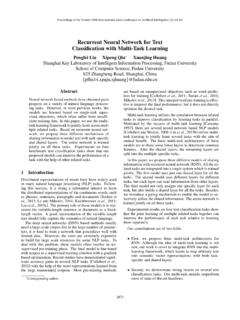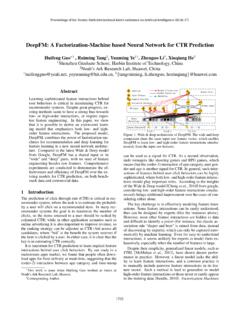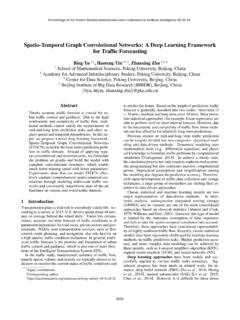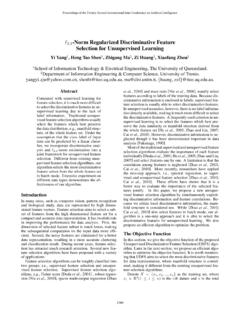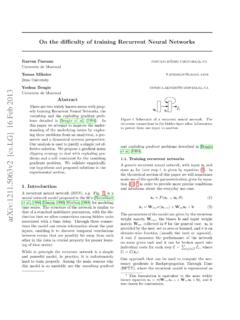Transcription of Detecting Rumors from Microblogs with Recurrent Neural ...
1 Proceedings of the Twenty-Fifth International Joint Conference on Artificial Intelligence (IJCAI-16). Detecting Rumors from Microblogs with Recurrent Neural Networks Jing Ma,1 Wei Gao,2 Prasenjit Mitra,2 Sejeong Kwon,3 Bernard J. Jansen,2. Kam-Fai Wong,1 Meeyoung Cha3. 1. The Chinese University of Hong Kong, Hong Kong SAR. 2. Qatar Computing Research Institute, Hamad Bin Khalifa University, Qatar 3. Graduate School of Culture Technology, Korea Advanced Institute of Science and Technology, Korea 1 2 3 Abstract Microblogging platforms are an ideal place for spreading Rumors and automatically debunking ru- mors is a crucial problem. To detect Rumors , ex- isting approaches have relied on hand-crafted fea- tures for employing machine learning algorithms (a) In Rumors (b) In non- Rumors that require daunting manual effort. Upon facing a dubious claim, people dispute its truthfulness by posting various cues over time, which generates Figure 1: Some shallow patterns signaling Rumors along long-distance dependencies of evidence.
2 This pa- events' timelines (in # of hours since initial tweets), where the per presents a novel method that learns continuous size of the shapes is the strength of their relative frequency representations of microblog events for identifying Rumors . The proposed model is based on recur- Debunking Rumors at an early stage of diffusion is partic- rent Neural networks (RNN) for learning the hidden ularly crucial to minimizing their harmful effects. To distin- representations that capture the variation of contex- guish Rumors from factual events, individuals and organiza- tual information of relevant posts over time. Ex- tions often have relied on common sense and investigative perimental results on datasets from two real-world journalism. Rumor reporting websites like and microblog platforms demonstrate that (1) the RNN. are such collaborative efforts.
3 However, be- method outperforms state-of-the-art rumor detec- cause manual verification steps are involved in such efforts, tion models that use hand-crafted features; (2) per- these websites are not comprehensive in their topical cover- formance of the RNN-based algorithm is further age and also can have long debunking delay. improved via sophisticated Recurrent units and ex- Existing rumor detection models use learning algorithms tra hidden layers; (3) RNN-based method detects that incorporate a wide variety of features manually crafted Rumors more quickly and accurately than existing from the content, user characteristics, and diffusion pat- techniques, including the leading online rumor de- terns of the posts [Castillo et al., 2011; Yang et al., 2012;. bunking services. Kwon et al., 2013; Liu et al., 2015; Ma et al., 2015.]
4 Wu et al., 2015], or simply exploited patterns expressed using regular expressions to discover Rumors in tweets [Zhao et al., 1 Introduction 2015]. Feature engineering is critical, but it is painstakingly Social psychology literature defines a rumor as a story or detailed, biased, and labor-intensive. For example, two time a statement whose truth value is unverified or deliberately series plots in Figure 1 depict the typical shallow patterns of false [Allport and Postman, 1965]. False Rumors are damag- rumor signals from [Zhao et al., 2015]. Although they could ing as they cause public panic and social unrest. For example, demonstrate temporal traits of rumor and non-rumor events, on August 25th of 2015, a rumor about shootouts and kid- differences between the two cases are neither clear-cut nor nappings by drug gangs happening near schools in Veracruz strong for feature engineering.
5 Spread through Twitter and Facebook1 . This caused severe On the other hand, deep Neural networks have demon- chaos in the city involving 26 car crashes, because people left strated clear advantages for many machine learning prob- their cars in the middle of a street and rushed to pick up their lems [Sutskever et al., 2011; 2014; Devlin et al., 2014;. children from school. This incident of a false rumor high- Kombrink et al., 2011; Cho et al., 2014]. In this research, lights that automatically predicting the veracity of informa- we explore opportunities to automatically discover and ex- tion on social media is of high practical value. ploit deep data representations for efficient rumor detection. We posit that given the sequential nature of text streams in 1. social media, Recurrent Neural networks (RNN) are suitable 3818. for rumor detection.
6 This is because the connections between variation of a set of social context features over time. Frig- units in an RNN form a direct cycle and create an internal geri, et al. [2014] characterized the structure of misinforma- state of the network [LeCun et al., 2015, Figure 5] that might tion cascades on Facebook by analyzing comments with links allow it to capture the dynamic temporal signals characteristic to rumor debunking websites. We also use the temporal prop- of rumor diffusion. erties of the representations, but the features are learned auto- Utilizing RNN, we model the social context information matically via an RNN given the fundamental term represen- of an event as a variable-length time series. We assume peo- tation in each time segment. ple, when exposed to a rumor claim, will forward the claim Zhao, et al. [2015] worked on early rumor detection using or comment on it, thus creating a continuous stream of posts.
7 Cue terms such as not true , unconfirmed or debunk to This approach learns both the temporal and textual represen- find questioning and denying tweets. Our RNN learns rep- tations from rumor posts under supervision. Extensive exper- resentations that are significantly more complex than these iments on two real-world microblog datasets demonstrate that explicit signals; these representations can capture the hidden the RNN-based method yields outstanding performance. The implications and dependencies over time. model is also shown to be effective for early detection of ru- Our work is also related to, but different from, stud- mors, where adequate accuracy could be achieved just several ies Detecting spammers [Lee et al., 2013; Wang, 2010;. hours after the initial propagation. Hu et al., 2013] and fake images on Twitter [Gupta et al.]
8 , The contributions of this paper are threefold: 2013], and the Truthy system [Ratkiewicz et al., 2011a;. To the best of our knowledge, this is a first study using a 2011b] that differentiates whether a meme is spreading or- deep learning model for rumor detection on Microblogs . ganically or is being spread by an astroturf campaign. RNN-based model achieves significant improvements over state-of-the-art learning algorithms that rely on on hand- crafted features. The model is furhter extensible and can 3 RNN: Recurrent Neural network detect Rumors more accurately than existing methods via sophisticated Recurrent units and extra hidden layers. An RNN is a type of feed-forward Neural network that can be used to model variable-length sequential information such The RNN-based model further allows for early detection, as sentences or time series.
9 A basic RNN is formalized as demonstrating a clear efficacy when compared to existing follows: given an input sequence (x1 , .. , xT ), for each time baselines such as leading online rumor debunking services. step, the model updates the hidden states (h1 , .. , hT ) and We constructed two microblog datasets with ground truth generates the output vector (o1 , .. , oT ), where T depends labels for the task, in total containing more than 5,000 on the length of the input. From t = 1 to T , the algorithm claims that scale to five million relevant microblog posts. iterates over the following equations: We make this large rumor dataset fully public to be used for research purposes2 . ht = tanh(Uxt + Wht 1 + b). (1). ot = Vht + c 2 Related Work where U, W and V are the input-to-hidden, hidden-to-hidden Automatic rumor detection from social media is based on and hidden-to-output weight matrices, respectively (see Fig- traditional classifiers that detect misinformation stemming ure 2(a) for the parameters of basic tanh-RNN), b and c are from the pioneering study of information credibility on Twit- the bias vectors, and tanh(.)
10 Is a hyperbolic tangent nonlin- ter [Castillo et al., 2011]. In following works [Yang et al., earity function. 2012; Liu et al., 2015; Ma et al., 2015; Wu et al., 2015], different sets of hand-crafted features were proposed and in- Typically, the gradients of RNNs are computed via back- corporated to determine whether a claim about an event is propagation through time [Rumelhart et al., 1986]. In prac- credible. Most of these prior works attempted to classify the tice, because of the vanishing or exploding gradients [Bengio veracity of spreading memes using information other than the et al., 1994], the basic RNN cannot learn long-distance tem- text content, for instance, the popularity of a post ( , the poral dependencies with gradient-based optimization. One number of retweets or replies of the post), the features rele- way to deal with this is to make an extension that includes vant to determine a user's credibility, etc.
